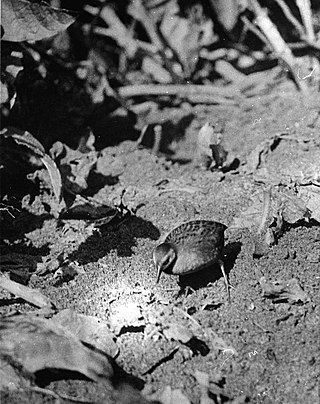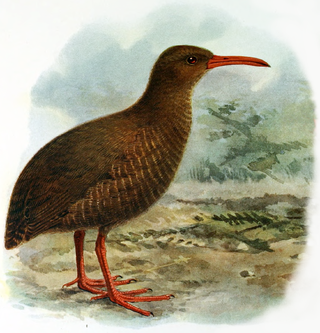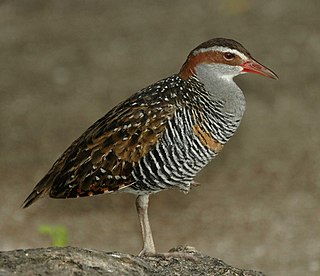
Rails are a large, cosmopolitan family of small- to medium-sized terrestrial and/or semi-amphibious birds. The family exhibits considerable diversity in its forms, and includes such ubiquitous species as the crakes, coots, and gallinule; other rail species are extremely rare or endangered. Many are associated with wetland habitats, some being semi-aquatic like waterfowl, but many more are wading birds or shorebirds. The ideal rail habitats are marsh areas, including rice paddies, and flooded fields or open forest. They are especially fond of dense vegetation for nesting. The rail family is found in every terrestrial habitat with the exception of dry desert, polar or freezing regions, and alpine areas. Members of Rallidae occur on every continent except Antarctica. Numerous unique island species are known.

The Inaccessible Island rail is a small bird of the rail family, Rallidae. Endemic to Inaccessible Island in the Tristan Archipelago in the isolated south Atlantic, it is the smallest extant flightless bird in the world. The species was formally described by physician Percy Lowe in 1923 but had first come to the attention of scientists 50 years earlier. The Inaccessible Island rail's taxonomic affinities and origin were a long-standing mystery; in 2018 its closest relative was identified as the South American dot-winged crake, and it was decided that both species are best classified in the genus Laterallus.
The Calayan rail is a flightless bird of the rail, moorhen, and coot family (Rallidae) that inhabits Calayan Island in the Philippines. It is the only member of the genus Aptenorallus. Though well known to natives of the island as the "piding", it was first observed by ornithologist Carmela Española in May 2004 and the discovery was officially announced on August 16, 2004. The formal description as a species new to science appeared in the journal Forktail.

The Laysan rail or Laysan crake was a flightless bird endemic to the Northwest Hawaiian Island of Laysan. This small island was and still is an important seabird colony, and sustained a number of endemic species, including the rail. It became extinct due to habitat loss by domestic rabbits, and ultimately World War II.

The Laysan millerbird was a subspecies of the millerbird, similar in appearance to the remaining subspecies, the Nihoa millerbird. Its dorsal side was brown, and its belly was grayish. Its name derives from its favorite food, several species of moths of the genus Agrotis commonly referred to as "millers".

Gallirallus is a genus of rails that live in the Australasian-Pacific region. The genus is characterised by an ability to colonise relatively small and isolated islands and thereafter to evolve flightless forms, many of which became extinct following Polynesian settlement.

The New Caledonian rail is a large and drab flightless rail endemic to the island of New Caledonia in the Pacific. It is Critically Endangered, may have gone extinct many decades ago already, and if it still exists it is one of the least-known living bird species.

The Tahiti rail, Tahitian red-billed rail, or Pacific red-billed rail is an extinct species of rail that lived on Tahiti. It was first recorded during James Cook's second voyage around the world (1772–1775), on which it was illustrated by Georg Forster and described by Johann Reinhold Forster. No specimens have been preserved. As well as the documentation by the Forsters, there have been claims that the bird also existed on the nearby island of Mehetia. The Tahiti rail appears to have been closely related to, and perhaps derived from, the buff-banded rail, and has also been historically confused with the Tongan subspecies of that bird.

The Saint Helena rail was a large flightless rail from Saint Helena. It became extinct in the early 16th century.

The invisible rail, Wallace's rail, or drummer rail is a large flightless rail that is endemic to the island of Halmahera in Northern Maluku, Indonesia, where it inhabits impenetrable sago swamps adjacent to forests. Its plumage is predominantly dark slate-grey, and the bare skin around its eyes, the long, thick bill, and the legs are all bright red. Its call is a low drumming sound which is accompanied by wing-beating. The difficulty of seeing this shy bird in its dense habitat means that information on its behaviour is limited.

The Chatham rail is an extinct flightless species of bird in the family Rallidae. It was endemic to Chatham, Mangere and Pitt Islands, in the Chatham archipelago of New Zealand. The Chatham rail was first discovered on Mangere in 1871, and 26 specimens collected there are known from museum collections. Its Māori name was "mātirakahu".

Cabalus is a disputed Oceanian genus of birds in the family Rallidae. Both species placed in the genus here were previously considered part of the genus Gallirallus, one was alternatively placed in Tricholimnas alone or together with the Lord Howe woodhen, and the other was initially included in Rallus.

Dieffenbach's rail, known in the Moriori language as meriki or mehoriki, is an extinct flightless species of bird from the family Rallidae. It was endemic to the Chatham Islands.

The Okinawa rail is a species of bird in the rail family, Rallidae. It is endemic to Okinawa Island in Japan where it is known as the Yanbaru kuina. Its existence was only confirmed in 1978 and it was formally described in 1981 although unidentified rails had been recorded on the island since at least 1973 and local stories of a bird known as the agachi kumira may refer to this species.

The Laysan honeycreeper, also known as the Laysan ʻapapane or Laysan honeyeater, is an extinct species of finch that was endemic to the island of Laysan in the Northwestern Hawaiian Islands. The bird was first recorded in 1828 and in 1892 received its scientific name from Walter Rothschild, who placed it in the genus Himatione along with the ʻapapane. The specific name, fraithii, refers to George D. Freeth, the self-appointed governor of Laysan, but was misspelled. Rothschild attempted to emend it to freethi in a later publication. This was accepted by most subsequent authors throughout the 20th century, and the bird was also considered a subspecies of the ʻapapane, as H. sanguinea freethii, for most of this time. By the 21st century, after further research, the original name was reinstated and it was considered a full species again. As a Hawaiian honeycreeper, a grouping within the finch subfamily Carduelinae, its ancestors are thought to have come from Asia.

The great Oʻahu rail or great Oʻahu crake is a little-known extinct bird species from Oʻahu, Hawaiʻi, attested only by a few subfossil bones. The holotype is a right tarsometatarsus found in a flooded sinkhole on the ʻEwa Plain near Barbers Point, the southwestern tip of Oʻahu.

The great Maui crake or great Maui rail is an extinct bird species from Maui, Hawaiian Islands, known only from subfossil bones. The holotype are the bones of one almost-complete skeleton, found in Auwahi Cave on the lower southern slope of Haleakalā at 1,145 m AMSL. Its first remains, however, were recovered in 1972 and/or 1974 from lower Waihoi Valley further east and less than half as far uphill.

Zapornia is a recently revalidated genus of birds in the rail family Rallidae; it was included in Porzana for much of the late 20th century. These smallish to tiny rails are found across most of the world, but are entirely absent from the Americas except as wind-blown stray birds. A number of species, and probably an even larger number of prehistorically extinct ones, are known only from small Pacific islands; several of these lost the ability to fly in the absence of terrestrial predators. They are somewhat less aquatic than Porzana proper, inhabiting the edges of wetlands, reedbelts, but also drier grass- and shrubland and in some cases open forest.

Hypotaenidia is a genus of birds in the family Rallidae. The genus is considered separate by the IOC and IUCN, while The Clements Checklist of Birds of the World / eBird consider the species to be part of Gallirallus. Since the mid-19th century, when these rather terrestrial birds were recognized to form a genus distinct from the decidedly aquatic Rallus, the validity of Hypotaenidia has been disputed.





















